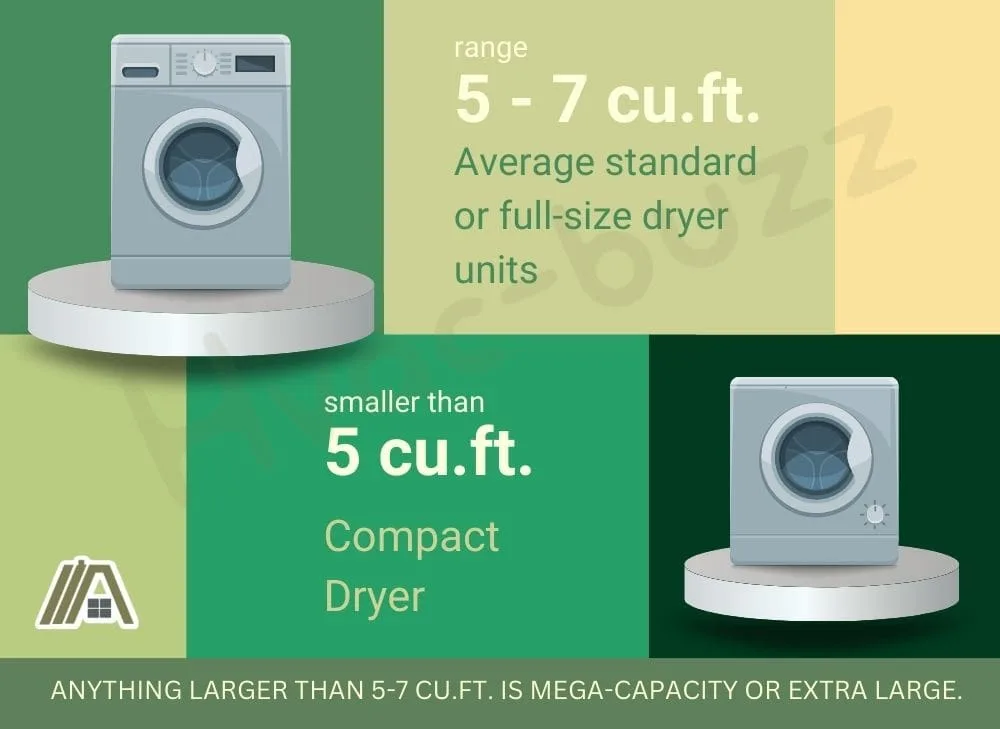Electric clothes dryers are one of the most convenient and efficient ways to do laundry. Almost 80% of American households include a clothes dryer. Tumble drying over line drying is faster and more convenient. However, an electric tumble dryer does come with its cons.
Dryers come in a range of sizes and capacities, and your electricity bill will vary depending on your dryer’s capacity and how often you use it. We looked at the top brands of electric dryers and compared their electricity usage as well as how much your dryer would, on average, cost you per year.

On average, an electric clothes dryer uses 1.9 kW of electricity per hour, 2.1 kW per load, 49.8 kW per month, and 597 kW of electricity per year.
Electric Dryer Sizes
When considering dryer capacity and which size is best for you and your family, a lot comes into consideration.
Are you a single person, or are you a family of four? Are you happy doing smaller loads of laundry 2 to 3 times a week, or do you prefer to do one large load once a week?
According to Whirlpool, the average dryer ranges from 5 to 7 cu.ft. These are your standard or full-size units. Anything smaller than 5 cu.ft. is considered compact, and anything larger is mega-capacity or extra large.
A single person living alone in a small flat might consider a smaller-sized compact dryer. A small family, or a couple wanting to expand their family, may choose a standard dryer.

Mega capacity dryers are the beasts of dryers with capacities over 8 cu.ft. Although, one does need to look carefully at individual manufacturers, as Samsung considers their 7.6 cu.ft. a mega capacity dryer.
Due to their size and limited demand, only 4 of the big brands of dryers have mega-capacity dryers currently on the market. Mega capacity dryers are for your very large families or those who prefer to do one big load of laundry once a week.
Before purchasing one of these dryers, you will need to measure your space carefully as these dryers can be larger than 23 inches in width. Another thing to consider is the larger the dryer, the more power and electricity it may use.
Power Rating of Electric Dryers
We took the power ratings of the leading brands of electric dryers and compared them against the available capacities.
Below is the average power rating of different capacities for Samsung, LG, GE, Whirlpool, Miele, Maytag, Electrolux, Kenmore, and Speedqueen vented dryers.
| Electric dryer capacity (cu. ft.) | Average power rating (W) | Average power rating (kW) |
| <4.0 | 2300 | 2.3 |
| 4.0-5.0 | 3000 | 3.0 |
| 6.0-7.0 | 5400 | 5.4 |
| 7.2 | 5500 | 5.5 |
| 7.3 | 5600 | 5.6 |
| 7.4 | 5600 | 5.6 |
| 7.5 | 5600 | 5.6 |
| 7.6 | 5400 | 5.4 |
| 7.8 | 5600 | 5.6 |
| 8.3 | 5600 | 5.6 |
| 9 | 5600 | 5.6 |
What we can see from this is that the smaller the dryer capacity, the less power it draws, up until about 7.2 cu. A smaller dryer has a smaller motor and does not need as much power to run as a larger dryer.
What’s interesting is dryers from 7.2 capacity and up tend to pull the same amount of power, 5.6 kW—even the mega-capacity dryers.
This means that if you are trying to decide if you need a standard or larger, you can just look at your available space as the actual cost of the unit.
Electricity Usage
After comparing the power ratings of the dryers, we then looked at their different electricity usages.
Using the data from individual manufacturers’ websites and the Energystar website, we were able to establish the dryer’s kWh/year ratings.
Kilowatt-hour or kWh is the kilowatt per hour used; this is a measure of energy, which is different from a kilowatt, a measure of power. kWh is how much energy, or in this case, electricity, an appliance uses in one hour. kWh/year is the amount of energy an appliance uses over a year.
The average consumer in America uses their machine 283 times a year. So, based on the kWh/year, we can determine the amount of electricity a dryer uses per hour by dividing its kWh/year by 283.

But dryer cycles are not always one hour long. So, to determine how much electricity a dryer uses per load, we need to look at the average cycle time length.
Compact dryers, on average, take under an hour for a complete cycle, while most standard dryers take under 70 minutes. Mega capacity dryers take over 70min for a cycle.
To determine the electricity used per load, we use the following equation:
kWh ÷ 60 minutes × Cycle time
So, if a dryer uses 2.1kWh and runs for 75min, the kW per load will be 2.6kW. We then use this to determine how much electricity your dryer will use per month and year.
The table below shows the electricity usage of the leading brands of electric vented dryers.
| Electric dryer capacity (cu. ft.) | Average power rating (kW) | Hourly electricity usage (kW) | Electricity usage per load (kW) | Electricity usage per month (kW) | Electricity usage per year (kW) |
| <4.0 | 2.3 | 0.7 | 0.7 | 16.1 | 193 |
| 4.0-5.0 | 3.0 | 0.8 | 0.6 | 14.8 | 178 |
| 6.0-7.0 | 5.4 | 2.1 | 2.4 | 56.6 | 679 |
| 7.2 | 5.5 | 2.1 | 2.4 | 57.4 | 689 |
| 7.3 | 5.6 | 2.1 | 2.2 | 52.9 | 634 |
| 7.4 | 5.6 | 2.1 | 2.4 | 55.9 | 670 |
| 7.5 | 5.6 | 2.1 | 2.4 | 57.0 | 684 |
| 7.6 | 5.4 | 2.1 | 2.5 | 60.0 | 719 |
| 7.8 | 5.6 | 2.1 | 2.6 | 62.1 | 745 |
| 8.3 | 5.6 | 2.1 | 2.3 | 54.0 | 649 |
| 9 | 5.6 | 2.1 | 2.6 | 60.8 | 730 |
Cost of Running an Electric Dryer
Now that we know how much electricity an electric dryer uses, how much would it cost you?
According to the U.S. Energy Information Administration, the average residential price of electricity is $0.16 per kWh. Using this average, we determined how much an electric dryer would cost per hour, load, month and year.
| Electric dryer capacity (cu. ft.) | Cost per hour ($) | Cost per load ($) | Cost per month ($) | Cost per year ($) |
| < 4.0 | 0.11 | 0.11 | 2.58 | 30.96 |
| 4.0-5.0 | 0.12 | 0.10 | 2.37 | 28.41 |
| 6.0-7.0 | 0.34 | 0.38 | 9.05 | 108.63 |
| 7.2 | 0.34 | 0.39 | 9.19 | 110.25 |
| 7.3 | 0.34 | 0.36 | 8.46 | 101.50 |
| 7.4 | 0.34 | 0.38 | 8.94 | 107.24 |
| 7.5 | 0.34 | 0.39 | 9.12 | 109.44 |
| 7.6 | 0.34 | 0.41 | 9.59 | 115.11 |
| 7.8 | 0.34 | 0.42 | 9.93 | 119.17 |
| 8.3 | 0.34 | 0.37 | 8.65 | 103.77 |
| 9 | 0.34 | 0.41 | 9.73 | 116.74 |
Larger capacity dryers will cost you more in electricity than their smaller counterparts. On average, a 7.8 cu.ft. dryer will use the most electricity and cost you the most as they have the longest average cycle time.
When comparing a mega-capacity dryer, you must consider that you may not use mega-capacity dryers as often as standard or compact dryers. Therefore, they may end up costing you less to run as you won’t be doing the average 283 loads per year.

The above information is all based on consumer and dryer averages. Costs will also vary depending on where you live and how much electricity costs you per kWh. It will also vary based on your laundry habits, how often you use your dryer and for how long.
For example, I only ever run the dryer for 10-15 minutes. I start by air-drying my clothes; then I just pop them in the dryer to get rid of the final dampness and the wrinkles.
These days most manufacturers try and keep their dryers as efficient as possible. When searching for a new electric dryer, look for the EnergyStar rating, as these are considered the most energy-efficient, for example, this LG 7.4 cu.ft electric dryer (amazon link).
Gas dryers still use electricity, but the amount that they use differs.
Sources
https://www.lg.com/us/electric-dryers
https://www.geappliances.com/ge-appliances/laundry/dryers/#/filter:ss_fuel_type:Electric
https://www.eia.gov/electricity/monthly/epm_table_grapher.php?t=epmt_5_6_a
https://justenergy.com/blog/kilowatts-and-calculations/
https://www.grandappliance.com/blog/grand-size-guide-washer-dryer
